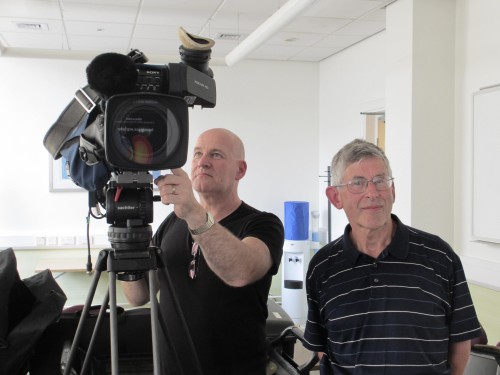
Liverpool physicist John Fry (right) gets ready for his close-up.
By Hamish Johnston
Earlier this week the Physics World film crew was on Merseyside to document some of the exciting physics done in Liverpool and its environs. Our first stop was a meeting of the NA62 collaboration at the University of Liverpool that was organized by the particle physicist John Fry (above right with our cameraman David Hart).
The finishing touches are currently being put on the NA62 experiment, which will start up at CERN in Geneva next year. The international collaboration running the experiment will focus on making precise measurements of the decay of a charged kaon to a pion and two neutrinos. If all goes to plan, NA62 could find that the decay is not completely described by the Standard Model of particle physics, which could point towards new and exciting physics.
We filmed Fry – along with his CERN-based colleagues Augusto Ceccucci, Ferdinand Hahn and Giuseppe Ruggiero – as part of a video feature on NA62 that will appear on physicsworld.com later this year.
While in Liverpool, we also recorded several videos for our 100 Second Science series on topics as varied as the importance of fundamental research and how to make pear-shape nuclei.
And to top it all off, we paid a visit to the Daresbury Laboratory on the opposite bank of the Mersey, where we filmed inside the SuperSTEM electron-microscope facility and the Cockcroft Institute.
So stay tuned for lots of great new physics videos!
Trackback: [Reblog]: Looking beyond the Standard Model in Liverpool | Io Non Faccio Niente
Good luck to the “NA62 experiment” at CERN with the charged kaon in the face of a total resistence so far by the SM concering all the work on the decay of different particles including the kaons. In fact this SM exclusiveness may suggest that there may be a desert in terms of new physics beyond it or the energies needed for the new things msy be too high for the earthly machines.
Just this experiment can go also behind energies we are able to produce in accelerators. New things we maybe? receive can move us to physics of higher energies.
well, also for these kind of new measurment researchers should use the more precise atomic clocks. Also most important experiments should be repeated with these clocks. Then we can say how much presice are these clocks and maybe just in kaon decay we can find experiments that if we can consider them as in more speed accelarated particle than in todays accelarator we can say we are maybe more precise than in controling it in LHC???
It is very difficult to understand why the decay of a particle seems the only way to know it…
The principal reason is the very short half-lives: less than 10^-20 s, of most of the SM- particles that forces one to measure their decay products and from them, reconstitute the original particle like the Higgs boson.